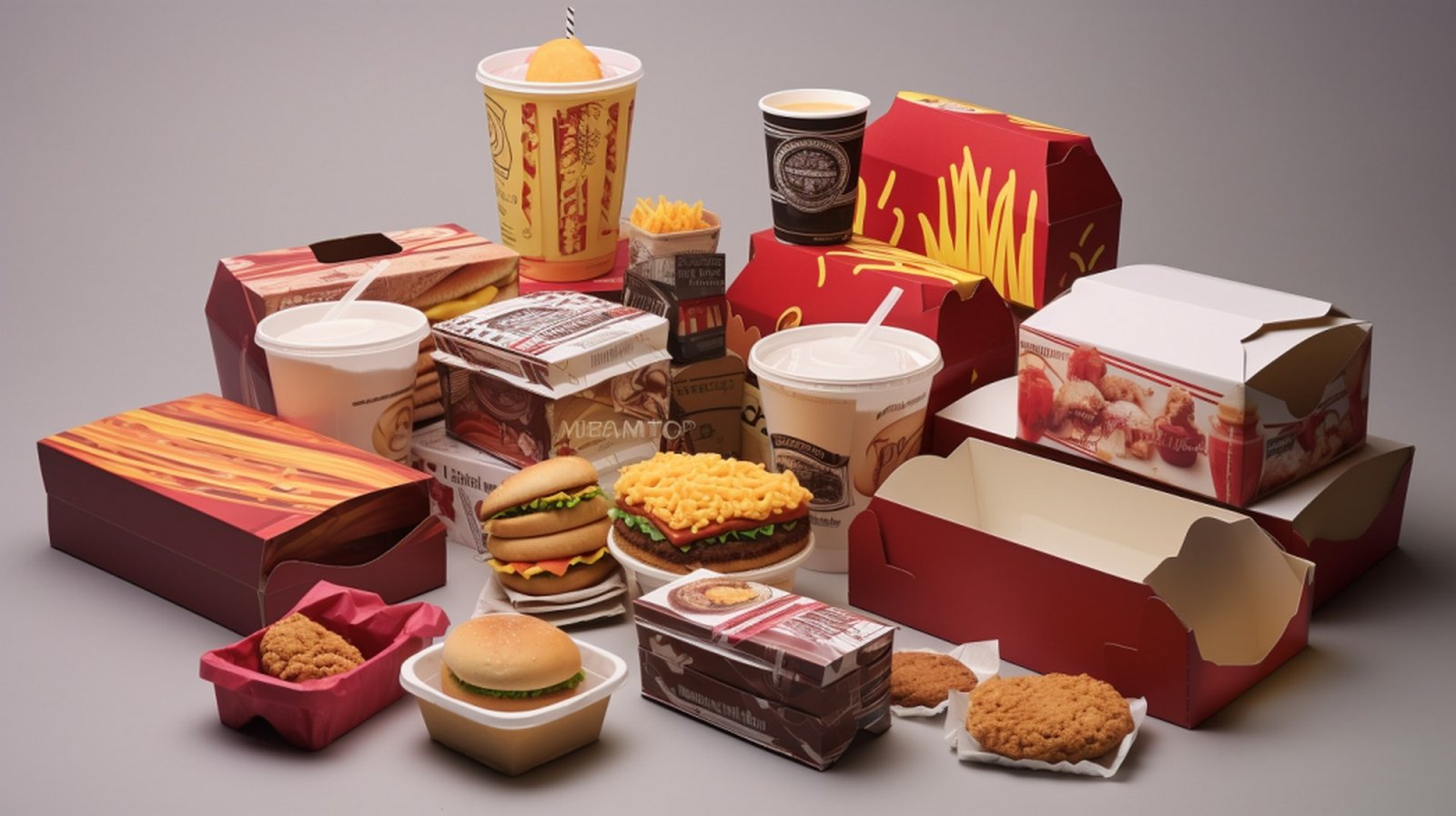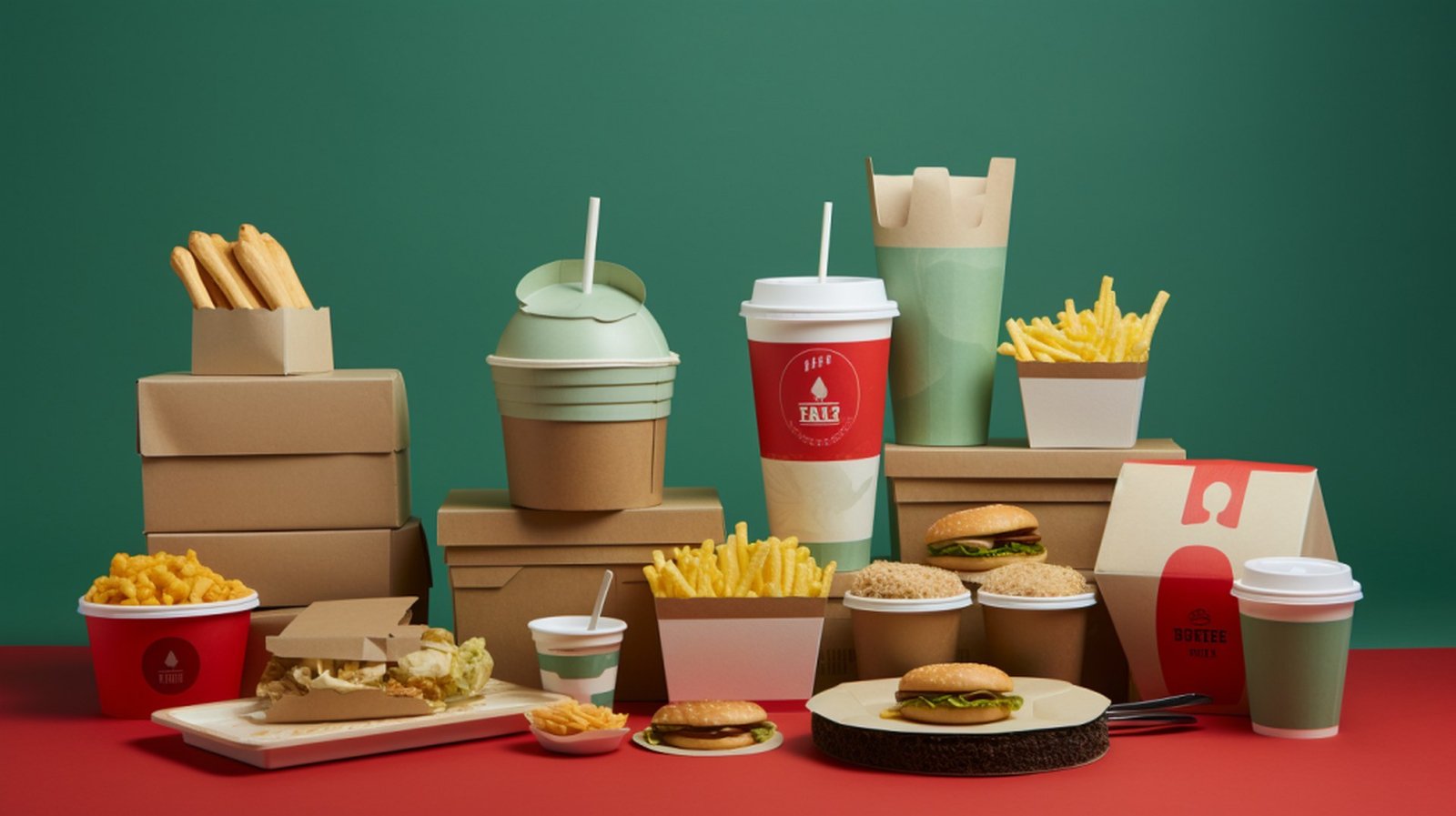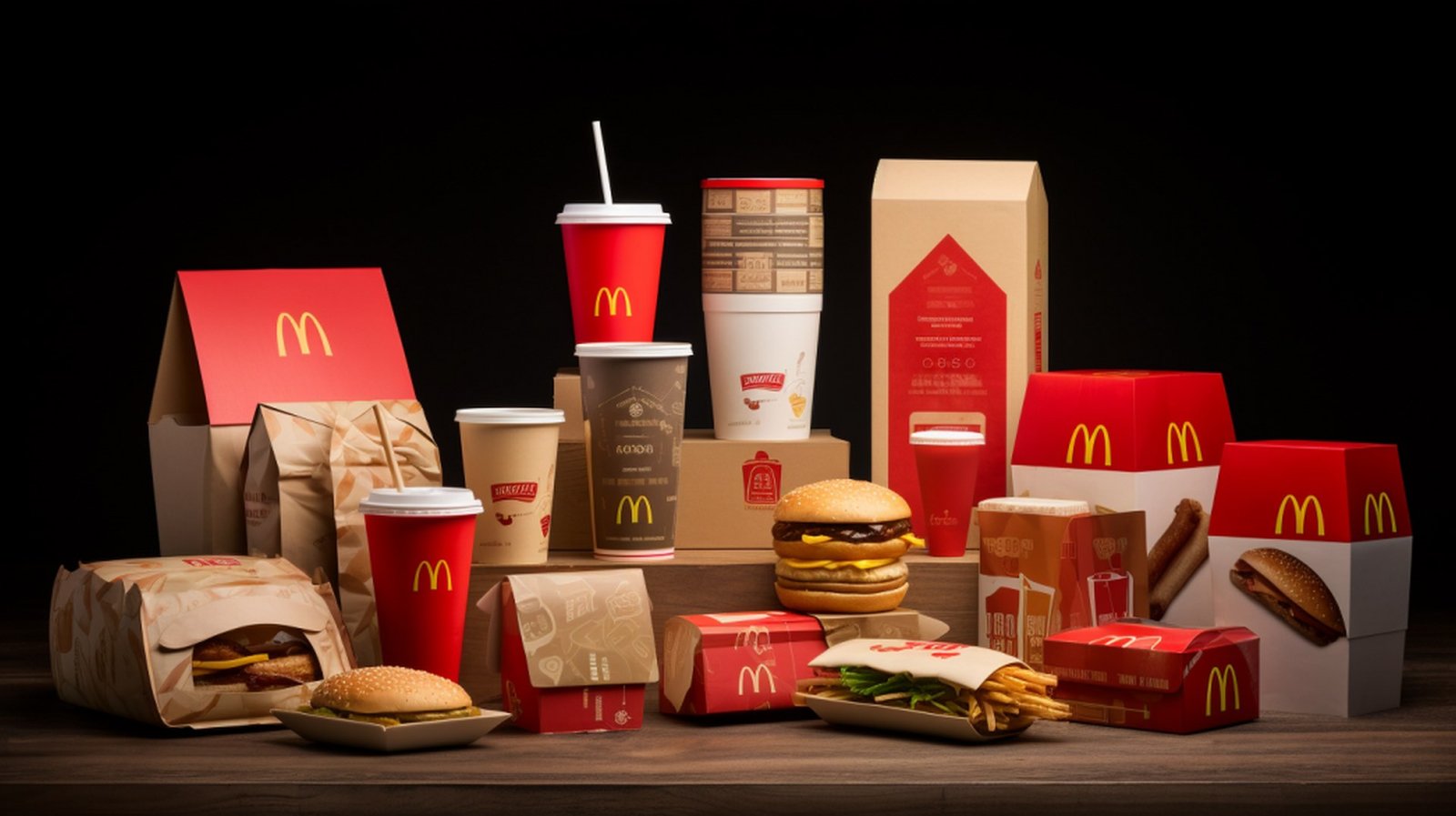Unveiling Fast Food Packaging: Types, Materials, and Environmental Impact
Fast food packaging is a pervasive environmental issue that demands attention due to its substantial impact.
The fast food industry, with its inherent emphasis on convenience and efficiency, generates a significant amount of packaging waste. Each year, approximately 300 million tons of plastic are produced globally, with a significant portion attributed to fast food packaging.
This article aims to explore the various types of fast food packaging, the materials used in their production, and the environmental consequences associated with their disposal.
Additionally, it will investigate how fast-food businesses are attempting to address this issue and examine potential eco-friendly solutions for reducing the environmental footprint of fast food packaging.
1.Types of Fast food Packaging

There are various types of fast food packaging that are commonly used in the industry. One of the most prevalent types is paper-based packaging, which includes paper bags and wraps. These are lightweight, inexpensive, and easily customisable with branding or logos.
Another type is plastic packaging, such as clamshells and containers made from polyethylene terephthalate (PET) or polystyrene (PS). Plastic packaging provides excellent durability and can be transparent to showcase the food inside.
Foam packaging is also widely used for hot items like burgers or fries due to its ability to retain heat effectively.
In addition to these primary materials, there are also specialized types of fast food packaging available. For instance, some establishments use aluminum foil pouches for grilled sandwiches or baked goods, as it offers good heat insulation properties. Furthermore, biodegradable and compostable materials have gained popularity in recent years due to their reduced environmental impact.
Transitioning into the subsequent section about 'fast food packaging materials and uses,' it is essential to understand how different materials influence the overall sustainability and ecological consequences of fast food packaging choices without compromising functionality or consumer satisfaction.
2.Fast Food Packaging Materials and Uses

One aspect of the study focuses on the diverse range of materials utilized in fast food packaging and their respective applications. Fast food packaging materials vary depending on the specific requirements of the product, as well as environmental and economic considerations.
Here are three common materials used in fast food packaging:
- Paper-based materials: Paperboard and corrugated cardboard are commonly used for burger boxes, French fry containers, and drink cups. These materials provide structural support and can be easily recycled.
- Plastic-based materials: Polyethylene terephthalate (PET) is often used for clear beverage cups and condiment containers due to its transparency and durability. Polystyrene foam is lightweight and provides insulation properties, making it suitable for hot beverage cups and takeaway containers.
- Aluminum-based materials: Aluminum foil is widely used for wrapping burgers or sandwiches to keep them warm. It offers excellent heat retention properties while being lightweight.
Understanding the different material options allows businesses to choose packaging that aligns with their sustainability goals while maintaining functionality. However, it is important to consider the environmental impact of these materials in terms of resource consumption, waste generation, and recycling feasibility.
This analysis leads us into a discussion about fast-food packaging waste facts...
3.Fast-Food Packaging Waste Facts

An examination of the waste generated by fast-food packaging brings to light alarming statistics regarding the volume of discarded materials and their potential consequences for the environment. Fast food establishments produce a significant amount of packaging waste due to the high demand for convenience and quick service. It is estimated that fast-food restaurants in the United States alone generate about 8 million tons of packaging waste annually. This waste includes various materials such as paper, plastic, foam, and aluminum.
The environmental impact of this massive volume of packaging waste is substantial. The disposal of these materials often leads to pollution and contributes to landfill overcrowding. Additionally, some packaging materials take hundreds or even thousands of years to decompose, further exacerbating environmental concerns.
In response to these challenges, fast-food businesses have been implementing various strategies to tackle packaging waste. Many companies are exploring alternative packaging materials that are more environmentally friendly and easily recyclable. Some examples include biodegradable containers made from plant-based materials or compostable plastics derived from renewable resources.
Moreover, fast-food chains are also promoting recycling initiatives within their establishments by providing designated recycling bins for customers and partnering with recycling organizations. These efforts aim to encourage proper disposal and increase recycling rates among consumers.
4.How Are Fast-Food Businesses Tackling Packaging Waste?

Fast-food businesses are actively addressing the issue of packaging waste through the implementation of innovative alternatives and improved recycling practices. To tackle this challenge, they are adopting various strategies:
- Sustainable Packaging: Many fast-food chains are transitioning towards eco-friendly packaging materials such as biodegradable or compostable containers made from plant-based sources like cornstarch or sugarcane fibers.
- Reduced Packaging: Some companies are focusing on minimizing packaging waste by using less material in their products, opting for smaller containers or eliminating unnecessary packaging components like plastic utensils or straws.
- Recycling Programs: Fast-food establishments are increasingly implementing recycling programs to ensure that their packaging is properly disposed of and recycled. They collaborate with waste management services to collect and recycle used containers, reducing the amount of waste sent to landfills.
These initiatives demonstrate a commitment within the fast-food industry to address the environmental impact of packaging waste. By embracing sustainable materials, reducing excess packaging, and implementing effective recycling programs, these businesses aim to mitigate their contribution to environmental degradation caused by fast food packaging.
Transitioning into the subsequent section about 'how fast food packaging affects the environment,' it is essential to understand the broader consequences of this issue beyond just waste management and recycling efforts.
5.How Fast food packaging affects the environment

Examining the consequences of fast food packaging on the environment reveals a range of detrimental effects, including resource depletion, pollution, and habitat destruction. Fast food chains produce vast amounts of packaging waste due to their high consumption rates and reliance on disposable materials. This waste not only contributes to the depletion of natural resources but also adds to pollution levels and causes habitat destruction.
One major environmental consequence of fast food packaging is resource depletion. The production of packaging materials requires significant amounts of energy, water, and raw materials such as paper, plastic, and aluminum. The extraction and processing of these resources contribute to deforestation, water scarcity, and increased greenhouse gas emissions.
Moreover, fast food packaging often ends up in landfills or as litter in the environment. Plastic containers and wrappers take hundreds or even thousands of years to decompose naturally. Improper disposal leads to pollution in various forms: air pollution from incineration processes; water pollution from leaching chemicals into groundwater; soil contamination from buried waste; and visual pollution from littered packaging.
Furthermore, the production and disposal processes associated with fast food packaging can result in habitat destruction. For example, deforestation for paper-based products destroys vital ecosystems that support biodiversity. Extraction activities for raw materials may also disrupt habitats through land clearing or fragmentation.
6.The impact of food packaging materials

Fast food packaging has a significant impact on the environment due to the materials used in its production and disposal. Understanding the environmental consequences of different food packaging materials is crucial in developing sustainable alternatives.
Here are three key types of food packaging materials and their environmental impacts:
- Plastic: Plastic is widely used in fast food packaging due to its affordability, durability, and versatility. However, its production involves fossil fuels extraction and contributes to greenhouse gas emissions. Moreover, plastic waste often ends up in landfills or pollutes oceans, taking hundreds of years to decompose.
- Paperboard: Paperboard is commonly used for items like burger boxes and French fry containers because it is lightweight and can be easily recycled or composted. However, the production of paperboard requires large amounts of water, energy, and chemicals such as bleach. Additionally, if not properly disposed of or recycled, paperboard can contribute to deforestation.
- Foam: Polystyrene foam (commonly known as styrofoam) is another material frequently used in fast food packaging due to its insulating properties. However, foam is non-biodegradable and takes thousands of years to break down into smaller pieces known as microplastics that can harm ecosystems.
Understanding these environmental impacts highlights the need for sustainable practices in fast food packaging design and disposal methods.
Transition sentence: The next section will focus on examining the specific issues related to water and land pollution resulting from improper handling of food packaging waste.
7.Water and Land Pollution from Food Packaging

Water and land pollution can result from improper handling of waste generated by the packaging used in the fast-food industry. The fast-food industry has a significant impact on the environment due to its immense production and consumption rates. Food packaging, including containers, wrappers, and bags, contributes to water and land pollution through various avenues.
Improper disposal of food packaging waste often leads to littering in both urban and natural environments. This litter can find its way into rivers, lakes, and oceans through storm drains or wind transport, causing water pollution. Additionally, when food packaging waste is disposed of in landfills without proper management or recycling efforts, it can contribute to soil contamination as harmful chemicals leach into the ground over time.
The impact of food packaging on birds and marine mammals is another critical aspect that needs consideration. Birds are particularly vulnerable to ingesting plastic fragments mistaken for food items such as fish eggs or insects. These plastic pieces can cause physical harm or even death due to blockages in their digestive systems. Similarly, marine mammals like seals or dolphins may mistake floating plastic bags for prey items like jellyfish and consume them accidentally. This ingestion can lead to internal injuries or suffocation.
With an understanding of the water and land pollution caused by improper handling of fast-food packaging waste established, it is important to examine how this impacts birds and marine mammals in further detail.
8.The Impact of Food Packaging on Birds and Marine Mammals

The presence of food packaging in natural environments poses a significant threat to the well-being of birds and marine mammals. Here are three ways in which food packaging negatively impacts these animals:
- Ingestion: Birds and marine mammals often mistake food packaging for prey and consume it. This can lead to serious health issues, such as intestinal blockages, malnutrition, and even death.
- Entanglement: Plastic bags, six-pack rings, and other types of food packaging can entangle birds and marine mammals, causing physical injuries or impairing their ability to swim or fly properly. This can result in reduced reproductive success, increased vulnerability to predators, and potential drowning.
- Habitat degradation: Food packaging that ends up in natural environments can degrade habitats used by birds and marine mammals for feeding, nesting, or resting purposes. For example, discarded plastic bags floating in water bodies can obstruct access to prey or breeding grounds for aquatic species.
As we transition into the subsequent section about air pollution from food packaging, it is important to note that the negative impact extends beyond direct harm to animals.
9.Air Pollution from Food Packaging

The impact of food packaging on birds and marine mammals has been previously discussed, highlighting the detrimental effects it can have on these species. However, another significant environmental concern associated with fast food packaging is air pollution. This subtopic aims to explore the various ways in which fast food packaging contributes to air pollution.
One major contributor to air pollution from fast food packaging is the production and disposal of polystyrene foam containers. Polystyrene foam, commonly known as Styrofoam, is widely used due to its lightweight and insulating properties. However, its production involves the release of hazardous chemicals into the atmosphere. Additionally, when polystyrene foam containers are incinerated or improperly disposed of in landfills, they release toxic gases and contribute to greenhouse gas emissions.
To provide a comprehensive overview of the environmental impact of different types of fast food packaging materials, a table has been included below:
| Packaging Material | Environmental Impact |
| Polystyrene Foam | Air pollution |
| Plastic | Marine pollution |
| Aluminum | Energy consumption |
| Paperboard | Deforestation |
| Biodegradable | Resource depletion |
Understanding the negative consequences associated with fast food packaging is crucial for developing eco-friendly solutions that minimize harm to the environment. The next section will focus on these sustainable alternatives and discuss current trends in fast food packaging.
10.Eco-Friendly Solutions and the Trend of Fast Food Packaging
One key aspect of eco-friendly solutions in the fast food industry involves adopting alternative materials and practices that reduce harm to the environment. This shift towards sustainability has gained momentum in recent years as businesses recognize the importance of minimizing their ecological footprint.
Here are three innovative eco-friendly solutions that are being implemented in the fast food packaging industry:
- Biodegradable Packaging: Many companies are now using biodegradable materials such as plant-based plastics, paper, and compostable materials for their packaging. These materials break down naturally over time, reducing waste and preventing pollution.
- Recycling Programs: Fast food chains are implementing recycling programs to encourage customers to dispose of their packaging responsibly. By providing designated recycling bins and educating consumers about proper disposal methods, these initiatives aim to increase recycling rates and reduce landfill waste.
- Sustainable Sourcing: Some fast food restaurants are prioritizing sustainable sourcing practices by using locally sourced ingredients and supporting suppliers who follow environmentally friendly farming techniques. This approach helps minimize transportation emissions and promotes biodiversity conservation.
These eco-friendly solutions not only contribute to reducing environmental harm but also enhance a company's reputation as a socially responsible business. As more fast food chains adopt these practices, the industry can make significant strides towards achieving sustainability goals while still meeting consumer demand for convenient, on-the-go meals.
In conclusion, fast food packaging has a significant environmental impact. It affects water and land pollution, harms birds and marine mammals, and contributes to air pollution.
However, there is a current trend towards eco-friendly solutions in the fast food industry. Businesses are starting to utilize sustainable materials and implementing recycling programs. These initiatives can help reduce packaging waste and mitigate the negative consequences on our planet.
It is imperative that we continue to support these efforts for the betterment of our environment and future generations.
Contact us Ecopacker for finding more eco-friendly fast food packaging solutions!
